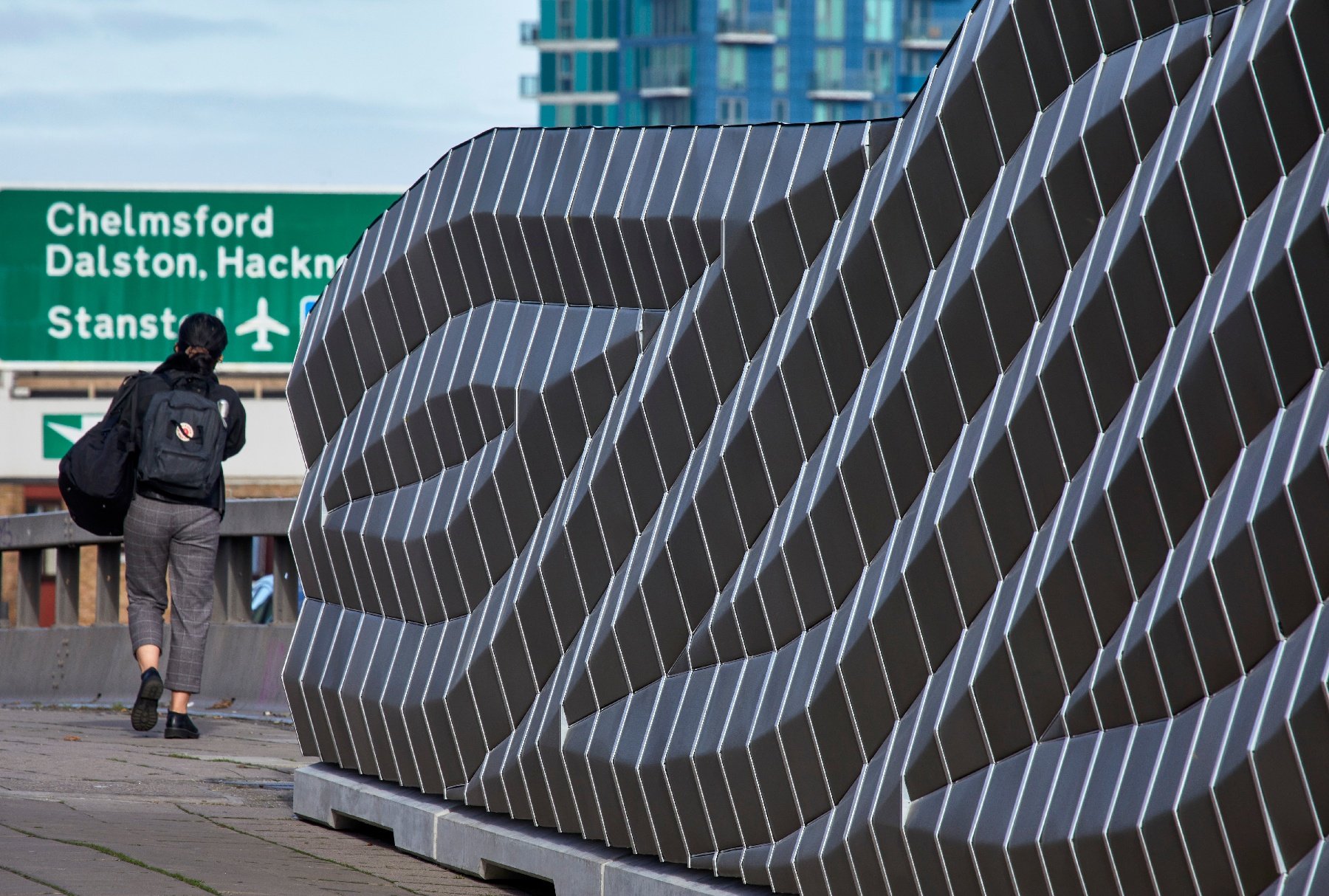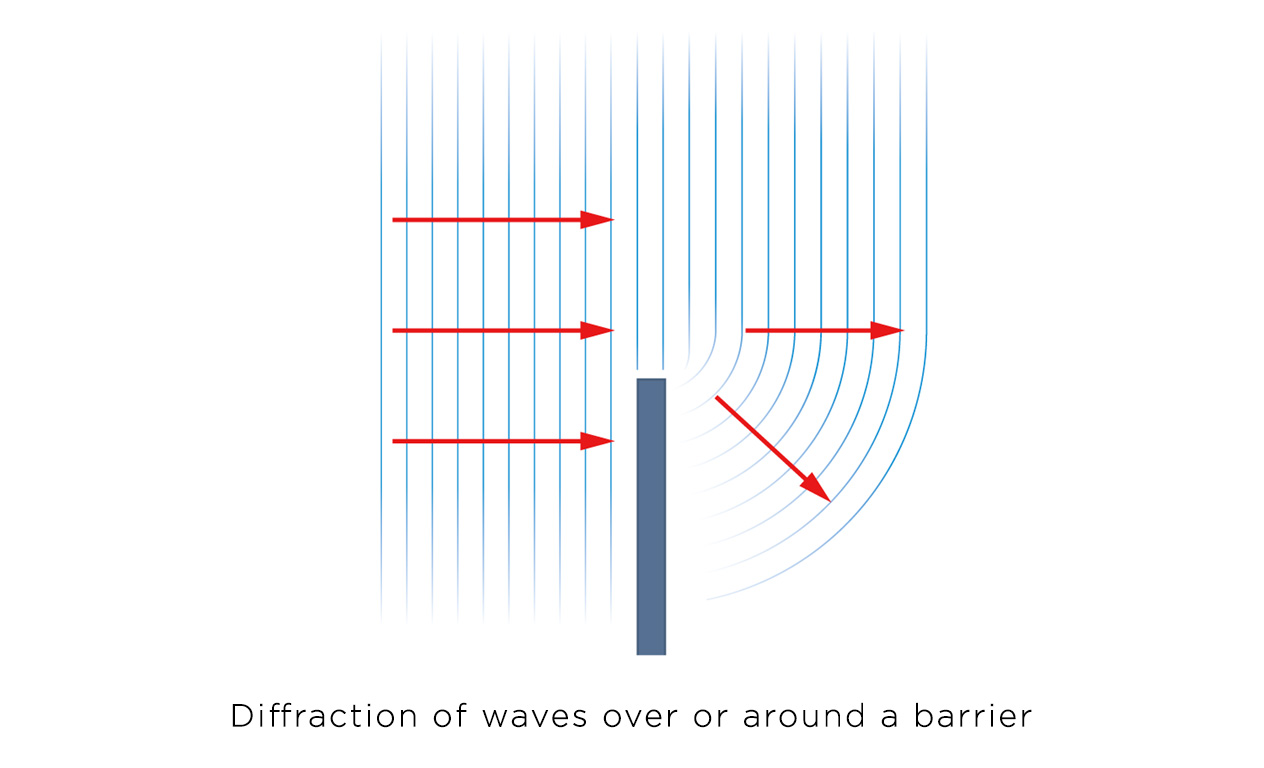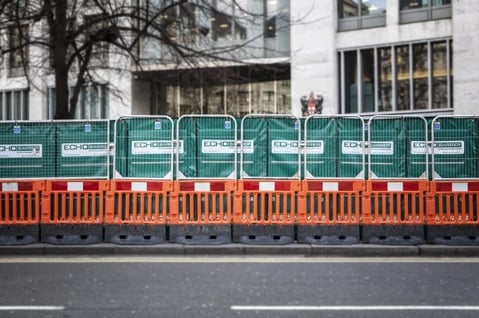
Tall concrete walls span more than 3 thousand miles of roadway across the US, separating suburban neighborhoods from noisy multi-carriage roads, representing half a century of traffic noise control efforts. While these giant noise barriers have provided acoustic protection for countless homes across the country, they have also inadvertently exacerbated the impact of traffic noise for many hapless citizens.
New technology currently being tested in the field in the United Kingdom shows promise in taking highway noise control to a new level, at long last. Successful demonstration of the noise wall technology could change the future of highway design, and drastically improve quality of life for thousands of people around and the world.
Employing measures to address the acoustic challenges presented by the growing volume of traffic in the United States began in the 1970s as more and more civil appeals and disputes started to emerge as a result of mounting noise pollution. Traffic noise on highways stems from several sources, including the exhaust and engine of vehicles, the sound of the body of the vehicle passing through air, and the noise caused friction between tyres and the asphalt. Noise walls are just one of multiple measures taken to minimize traffic noise, while others include optimizing the quality of the road surface to reduce surface noise and improving and regulating car exhaust and engine technology.

Any houses situated near this roadway may experience disruptive levels of noise pollution.
Usually, when an interstate roadway is looking to be expanded or newly built, the potential impact of future traffic will be assessed using a model that makes predictions of the effects of its noise for the decades to come. The government sets a threshold of 67 dB to justify the installation of sound walls, as long as it is “reasonable and feasible” to reduce the noise level by at least 5 dB for a portion of homes. However, the currently available solutions are a tolerated double-edged sword, reducing noise levels heard in some homes while increasing them in others.
The Current Solution Comes With Problems
Applying sheer mass has been the go-to way to construct highway noise walls for as long as they’ve been around, using materials like concrete, wood, plastic, and steel. This is a great way to increase transmission loss, preventing almost all noise from passing through the noise wall, which provides a great solution for residences situated close to the wall. However, it may not only provide no remedy whatsoever for houses multiple blocks beyond the edge of the road, but in fact worsen it, or create a new noise problem altogether for those that never had one to begin with. This is possible owing to certain acoustical phenomena that happen on a roadway lined with noise walls.
Noise Reflection Is The Biggest Issue
The materials typically used for constructing highway noise walls are very dense, making them fantastic sound insulators with high STC (sound transmission class) ratings. What this means is that very little sound energy passes through the barrier and out the other side. But there’s a catch to using these types of materials: their surfaces are, acoustically, highly reflective. 60% or more of the sound energy that reaches a surface like concrete bounces back off it. This makes a barrier-lined roadway effectively into a sort of “acoustic pong”, where sound bounces back and forth, sending even more sound spilling over the barrier and reaching further into the distance. Houses that find themselves in weaker parts of the acoustic shadow cast by the roadway noise wall, or outside of it all together, can experience even worse noise levels than there would be if there were no noise wall at all.
But how is that so?
Physics of A Noise Wall
Wave diffraction is responsible for the reduced efficacy of a noise wall’s noise levels over certain distances. Diffraction describes the ability of sound waves to bend around corners and over walls. This explains why you can still hear a sound through an opening or from the other side of a concrete barrier, for example, even though you can’t see the source of the noise. The further from the barrier the noise receiver (a human listener, for example) is located, the smaller the angle between the top of the barrier and the receiver’s position, and therefore more diffracted noise will reach the receiver.

"Spillage" of noise over a barrier is inevitable.
This protected space between the wall and the receiver is known as an “acoustic shadow”. Towards the edges of the shadow and further away from the barrier, there is less protection from noise. Closer to the noise wall and furthest from its edge (that is, at a larger angle from the horizontal plane) is where the most noise reduction is achieved. Of course, in accordance with the inverse square law, distance is also a key factor in the overall level of noise reduction. The inverse square law shows that the doubling of the distance from a noise source results in a reduced sound pressure level of 6 dB, so it serves to also be located further from the noise wall – and therefore the noise source – even though the acoustic shadow is weaker at a distance.
This is an inevitable trait of open-air acoustic treatment methods, regardless of the material type. The issue in the specific case of highway noise walls is, rather, the flawed acoustic properties of the materials used to make the walls that cause the reflections.

Traffic noise bounces between noise walls, increasing the amount of sound energy that escapes over them.
So, why not just build walls from more absorptive materials, such as those used indoors in homes, office spaces, and studios? The issue with these porous types of materials, including Rockwool and foam, is that they lack the durability and strength necessary to withstand long-term installation outdoors, while also being dangerously flammable. Fibreglass has considerable noise absorption properties also, although it offers a lower degree of transmission loss.
The solution to highly effective highway traffic noise control lies in a design that takes the strongest features from the variety of acoustic material types; the strength and ability to block sound offered by massive materials like steel or concrete, while applying the sound-absorbing form and properties of porous materials like foam, Rockwool and fibreglass.
The Future Of Highway Noise Walls
The year 2020 has presented us with what looks to be the future of highway noise control. Echo Barrier is a company that develops innovative acoustic barrier technology, addressing the faults of outdated noise control solutions, and highway traffic noise is their next frontier. In collaboration with Transport for London (TFL), Echo Barrier and a team of designers have presented a noise wall design that minimizes reflections and maximizes the noise absorption, unlike any other solution currently available. The proof of concept was produced specifically to resolve ongoing difficulties presented by traffic noise on an intersection of the A12, a major road in London, United Kingdom. The wall is installed on a short stretch of the A12’s roadside, reaching 10 feet high and lining 100-odd feet of the road.

The one-of-a-kind design comprises over 60 modular “cases” constructed from innovative acoustic materials, devised such that they absorb the traffic noise instead of reflecting it back toward the roadway and into surrounding buildings, augmenting its severity and the perceived loudness of traffic for residents.
The effectiveness of the noise wall is currently being verified as the University of East London continues to monitor its technical performance and the reception from the public, but the project shows promise. The successful implementation of the noise wall will result in its widespread installation across other sensitive sections of the A12, with installation on other roadways across the United Kingdom and the world potentially following suit.
Noise control, long or short term
Echo Barrier designs innovative temporary noise control system designed to mitigate noise in dynamic and sensitive work environments.


